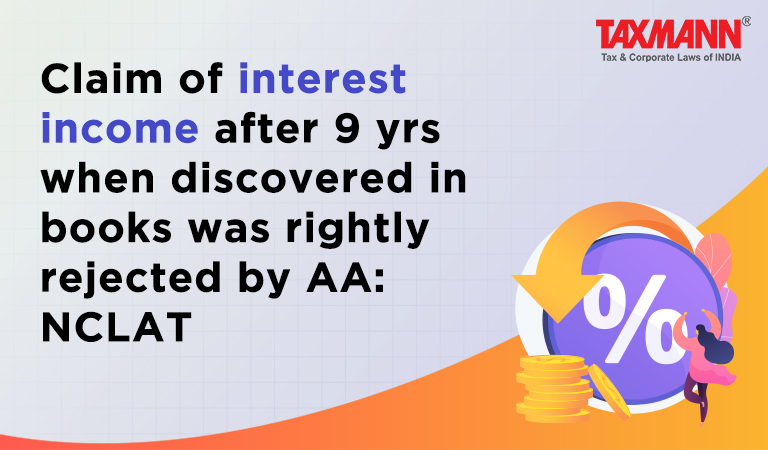Claim of interest income after 9 yrs when discovered in books was rightly rejected by AA: NCLAT
- Blog|News|Insolvency and Bankruptcy Code|
- 2 Min Read
- By Taxmann
- |
- Last Updated on 18 April, 2022
Case Details: Himalayan Crest Power (P.) Ltd. v. Pankaj Khaitan, Resolution Professional of Sasi Power (P.) Ltd. - [2022] 137 taxmann.com 56 (NCLAT- New Delhi)
Judiciary and Counsel Details
-
- Anant Bijay Singh, Judicial Member and Ms. Shreesha Merla, Technical Member
- Ms.Purti Gupta and Ms. Heena George, Advs. for the Appellant.
- Neeraj Kumar Gupta, Adv. for the Respondent.
Facts of the Case
In the instant case, the appellant-financial creditor had provided a loan facility to the corporate debtor. The Corporate debtor was unable to discharge its liability and CIRP was initiated against it. The appellant filed its claim towards the principal amount and interest amount. The Resolution Professional only admitted the claim towards the principal amount and rejected the interest component.
The NCLT by impugned order rejected the appellant’s claim towards the interest component – Whether interest was nowhere reflected in audited financial statements of the corporate debtor or appellant.
NCLAT Held
The NCLAT observed that since the interest was never booked as an expense by the corporate debtor and was never recognized as income by the appellant, the statement of accounts purporting to be the ledger account of the appellant in the books of the corporate debtor was bogus as the same did not match with audited account nor did it match with tally data by ex-director of the corporate debtor.
The Appellate Tribunal held that since there was an inordinate delay of 9 years in recognizing interest income by the appellant in its balance sheet and also there was no corresponding booking of interest in its accounts by the corporate debtor, the NCLT rightly rejected the application filed by the appellant.
Case Review
-
- Himalyan Crest Power Ltd. v. Resolution Professional [2022] 137 taxmann.com 55 (NCLT – New Delhi) (para 19) affirmed [See annex].
List of Cases Referred to
-
- Hussan Kadri v. Edelweiss Asset Reconstruction Co. Ltd. [2020] 117 taxmann.com 388/160 SCL 190 (NCLAT – New Delhi) (para 6)
- S. Natarajan v. Sama Dharman [Crl. Appeal No. 1524 of 2014, dated 15-7-2014] (para 7)
- Vivek Jha v. Daimler Financial Services India (P.) Ltd. [2020] 117 taxmann.com 98/162 SCL 159 (NCLAT – New Delhi) (para 7)
- Asset Reconstruction Co. (India) Ltd. v. Bishal Jaiswal [2021] 126 taxmann.com 200/166 SCL 82 (SC) (para 8)
- Urvashi Aggarwal v. Kushagr Ansal [Civil Appeal No. 2525 of 2019, dated 6-3-2019] (para 13).
Disclaimer: The content/information published on the website is only for general information of the user and shall not be construed as legal advice. While the Taxmann has exercised reasonable efforts to ensure the veracity of information/content published, Taxmann shall be under no liability in any manner whatsoever for incorrect information, if any.

Taxmann Publications has a dedicated in-house Research & Editorial Team. This team consists of a team of Chartered Accountants, Company Secretaries, and Lawyers. This team works under the guidance and supervision of editor-in-chief Mr Rakesh Bhargava.
The Research and Editorial Team is responsible for developing reliable and accurate content for the readers. The team follows the six-sigma approach to achieve the benchmark of zero error in its publications and research platforms. The team ensures that the following publication guidelines are thoroughly followed while developing the content:
- The statutory material is obtained only from the authorized and reliable sources
- All the latest developments in the judicial and legislative fields are covered
- Prepare the analytical write-ups on current, controversial, and important issues to help the readers to understand the concept and its implications
- Every content published by Taxmann is complete, accurate and lucid
- All evidence-based statements are supported with proper reference to Section, Circular No., Notification No. or citations
- The golden rules of grammar, style and consistency are thoroughly followed
- Font and size that’s easy to read and remain consistent across all imprint and digital publications are applied








 CA | CS | CMA
CA | CS | CMA


